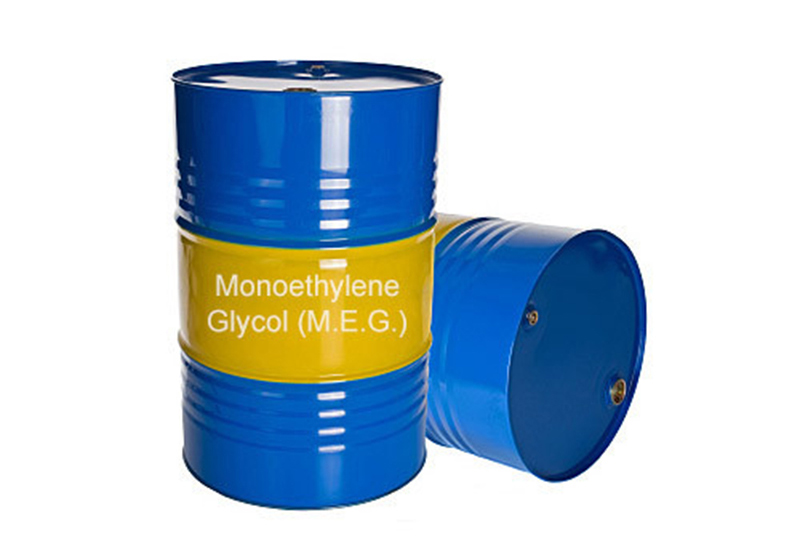Ethylene glycol is a colorless, practically odorless, low-volatility, low-viscosity, hygroscopic liquid. It is completely miscible with water and many organic liquids. Ethylene glycol is produced from ethylene, via the intermediate ethylene oxide. Ethylene oxide reacts with water to produce ethylene glycol. Ethylene glycol (Monoethylene Glycol) in its pure form, it is an odorless, colorless, syrupy liquid with a sweet taste.
The hydroxyl groups on glycols undergo the usual alcohol chemistry, giving a wide variety of possible derivatives. Hydroxyls can be converted to aldehydes, alkyl halides, amines, azides, carboxylic acids, ethers, mercaptans, nitrate esters, nitriles, nitrite esters, organic esters, peroxides, phosphate esters and sulfate esters.
This chemistry permits ethylene glycol to act as an intermediate in a wide range of reactions. Especially significant is resin formation, including the condensation with dimethyl terephthalate or terephthalic acid resulting in a polyester resin. The reactivity and solubility of ethylene glycol provide the basis for many applications. The widespread use of ethylene glycol as an antifreeze is based on its ability to lower the freezing point when mixed with water. The physical properties of ethylene glycol-water mixtures are therefore extremely important. The end uses for ethylene glycol are numerous.
Monoethylene glycol (MEG) is an important raw material for industrial applications. A primary use of MEG is in the manufacture of polyester (PET) resins, films and fibers. In addition, MEG is important in the production of antifreezes, coolants, aircraft anti-icer and deicers and solvents.
MEG is a basic building block used for applications that require:
Chemical intermediates for resins
Solvent couplers
Freezing point depression solvents
Humectants and chemical intermediates
The major use of ethylene glycol is as a medium for convective heat transfer in, for example, automobiles and liquid-cooled computers. Ethylene glycol is also commonly used in chilled-water air-conditioning systems that place either the chiller or air handlers outside, or systems that must cool below the freezing temperature of water. In geothermal heating/cooling systems, ethylene glycol is the fluid that transports heat through the use of a geothermal heat pump.
Pure ethylene glycol freezes at about −12 °C (10.4 °F) but, when mixed with water, the mixture freezes at a lower temperature. For example, a mixture of 60% ethylene glycol and 40% water freezes at −45 °C (−49 °F). Because of the depressed freezing temperatures, ethylene glycol is used as a de-icing fluid for windshields and aircraft, as an antifreeze in automobile engines, and as a component of vitrification (anticrystallization) mixtures for low-temperature preservation of biological tissues and organs. Mixture of ethylene glycol and water can also be chemically termed as glycol concentrate/compound/mixture/solution.
These applications are vital to the manufacture of a wide variety of products, including:
Resins
Deicing fluids
Heat transfer fluids
Automotive antifreeze and coolants
Water-based adhesives
Latex paints and asphalt emulsions
Electrolytic capacitors
Textile fibers
Paper
Leather



stromectol 2mg online – order tegretol sale buy carbamazepine without prescription
accutane 20mg tablet – dexona online order buy zyvox 600 mg pill
purchase amoxil generic – order valsartan pills combivent usa
azithromycin 250mg for sale – how to buy azithromycin buy generic nebivolol
order prednisolone 20mg generic – buy azithromycin without prescription order progesterone 200mg
generic gabapentin 800mg – purchase sporanox for sale sporanox 100 mg for sale
buy furosemide 100mg sale – furosemide oral cost betnovate 20gm
doxycycline for sale – buy ventolin inhalator for sale glipizide 5mg usa
cheap clavulanate – ketoconazole 200mg oral where to buy cymbalta without a prescription
order rybelsus online – cyproheptadine 4 mg drug cyproheptadine pill
buy tizanidine – cheap plaquenil microzide for sale
viagra 50mg pill – purchase sildenafil sale cheap tadalafil sale
real cialis sites – tadalafil 5mg usa cheap sildenafil sale
order cenforce for sale – order chloroquine generic buy glucophage 500mg pill
buy atorvastatin without prescription – buy zestril pills order lisinopril generic
buy omeprazole 10mg – metoprolol 100mg without prescription atenolol 100mg without prescription
methylprednisolone usa – triamcinolone price aristocort 4mg pills
order generic clarinex 5mg – generic desloratadine 5mg dapoxetine 30mg sale
cytotec brand – orlistat over the counter diltiazem price
order zovirax 400mg online cheap – zyloprim medication crestor 10mg canada
buy generic motilium – flexeril tablet cyclobenzaprine price
domperidone pills – tetracycline 500mg pills flexeril 15mg us
buy medex online – buy cozaar 25mg online buy cozaar 50mg generic
nexium 40mg ca – purchase topiramate online buy generic sumatriptan 25mg
levofloxacin 500mg without prescription – avodart 0.5mg pill buy ranitidine online
order mobic pill – meloxicam 7.5mg tablet flomax buy online
order ondansetron without prescription – order aldactone 25mg for sale zocor 10mg us
purchase modafinil online cheap generic modafinil 200mg provigil price buy generic provigil provigil 200mg price modafinil price modafinil drug
I am actually happy to gleam at this blog posts which consists of tons of worthwhile facts, thanks for providing such data.
The depth in this serving is exceptional.
buy azithromycin 500mg sale – buy generic sumycin over the counter flagyl 400mg for sale
semaglutide 14 mg ca – buy periactin 4 mg generic order periactin 4 mg generic
motilium 10mg us – flexeril cheap cyclobenzaprine 15mg sale
order inderal online – buy propranolol for sale buy methotrexate 5mg for sale
amoxil cost – order valsartan 80mg pill purchase ipratropium pills
zithromax 500mg oral – order azithromycin for sale nebivolol 5mg usa
purchase augmentin generic – atbioinfo.com ampicillin pill
order nexium sale – anexa mate nexium 20mg usa
coumadin sale – coumamide hyzaar for sale
buy mobic 15mg – https://moboxsin.com/ mobic generic
deltasone price – https://apreplson.com/ oral deltasone 20mg
online ed meds – fastedtotake.com otc ed pills
buy cheap generic amoxil – https://combamoxi.com/ amoxicillin canada
diflucan 200mg drug – forcan order buy fluconazole 100mg generic
escitalopram medication – order lexapro 10mg for sale escitalopram 20mg cheap
buy cenforce no prescription – https://cenforcers.com/ buy cenforce generic
cialis vs flomax for bph – https://ciltadgn.com/ cialis leg pain
buy zantac cheap – https://aranitidine.com/ ranitidine generic
where to buy cialis online for cheap – https://strongtadafl.com/ tadalafil generic headache nausea
This is a keynote which is in to my fundamentals… Myriad thanks! Exactly where can I notice the connection details an eye to questions? https://gnolvade.com/
order viagra in south africa – site cheap kamagra/viagra
Greetings! Extremely serviceable suggestion within this article! It’s the petty changes which wish make the largest changes. Thanks a a quantity for sharing! zithromax price
This is the kind of information I enjoy reading.
More articles like this would remedy the blogosphere richer. https://ursxdol.com/get-metformin-pills/
More posts like this would persuade the online time more useful. https://prohnrg.com/
I truly appreciated the approach this was laid out.
The thoroughness in this section is noteworthy. https://aranitidine.com/fr/cialis-super-active/
This post is incredible.
I particularly enjoyed the style this was laid out.
Such a valuable insight.
I discovered useful points from this.
More articles like this would make the online space a better place.
I’ll gladly return to read more.
I’ll surely recommend this.
Such a helpful resource.
I gained useful knowledge from this.
I truly enjoyed the way this was presented.
More articles like this would make the blogosphere better.
Such a valuable read.
I absolutely valued the style this was presented.
The breadth in this article is praiseworthy.
More posts like this would persuade the online space more useful. https://ondactone.com/product/domperidone/
I really appreciated the way this was written.
I am in truth thrilled to glance at this blog posts which consists of tons of worthwhile facts, thanks representing providing such data.
https://proisotrepl.com/product/methotrexate/
More text pieces like this would insinuate the интернет better. http://www.orlandogamers.org/forum/member.php?action=profile&uid=29102
order dapagliflozin 10 mg sale – order dapagliflozin online cheap forxiga 10 mg sale
brand xenical – https://asacostat.com/ orlistat 120mg cheap
More delight pieces like this would make the web better. http://shiftdelete.10tl.net/member.php?action=profile&uid=205621
You can shelter yourself and your dearest by way of being cautious when buying medicine online. Some pharmacopoeia websites operate legally and put forward convenience, solitariness, rate savings and safeguards for purchasing medicines. buy in TerbinaPharmacy https://terbinafines.com/product/tadapox.html tadapox
I couldn’t weather commenting. Profoundly written! lasix 40 mg posologie
The vividness in this tune is exceptional.